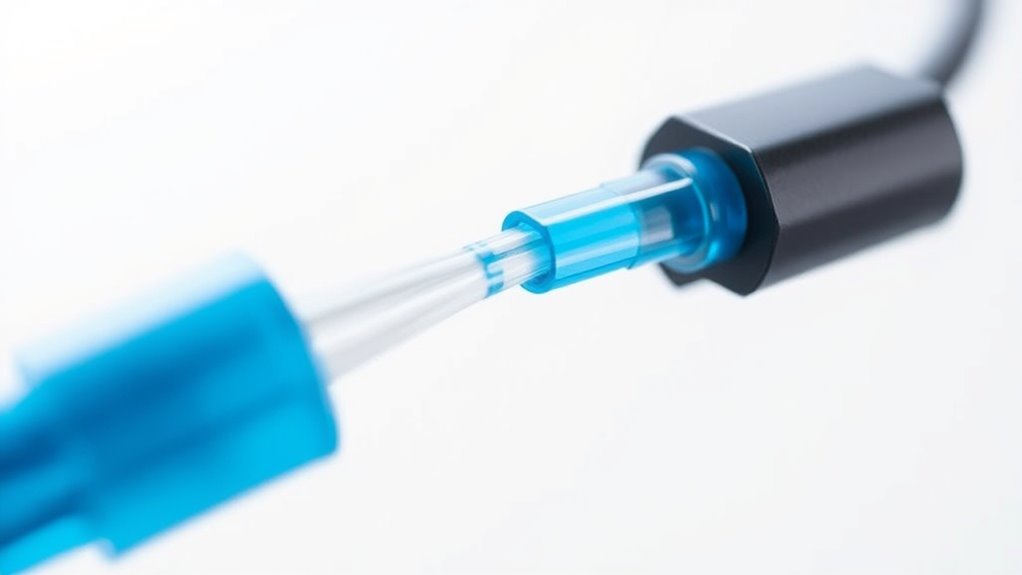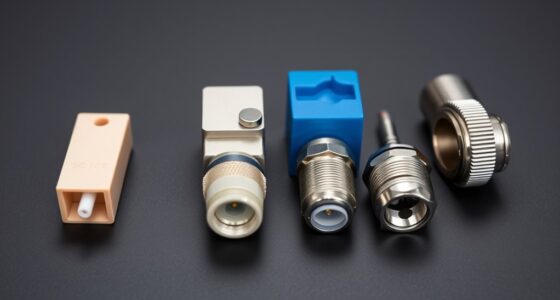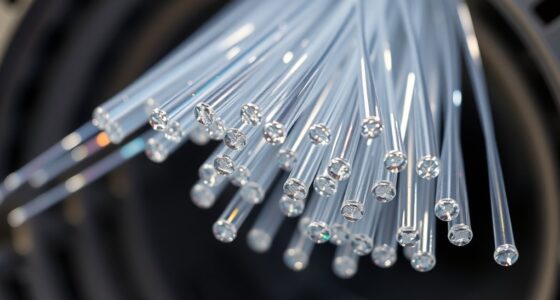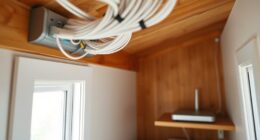Maintaining the proper bend radius in fiber optics is vital because it prevents signal loss, microbends, and potential cable damage. If you bend the cable too tightly, you risk degrading the signal quality or causing physical harm to the fiber. Following recommended bend radius guidelines helps guarantee long-term performance and reliability of your network. Keep an eye on how you handle and install your cables—there’s more to learn that can keep your system running smoothly.
Key Takeaways
- Exceeding bend radius causes signal loss and fiber damage, compromising network performance.
- Proper bend radius guidelines prevent microbends and macrobends that impair signal quality.
- Following specifications ensures long-term fiber integrity during installation and operation.
- Using appropriate tools and techniques maintains safe bends and prevents physical stress on fibers.
- Ignoring bend radius guidelines can lead to costly repairs and increased downtime.

Understanding the cable bend radius in fiber optics is essential because exceeding it can cause signal loss or damage to the fibers. When you’re managing fiber optic cables, proper fiber management becomes vital to maintain the integrity of your network. One of the key aspects of fiber management is adhering to the recommended bend radius during installation and everyday use. If you bend a fiber optic cable too tightly, it can lead to microbends or macrobends, which impair signal quality and may eventually cause cable failure. That’s why knowing and respecting the bend radius is central to following installation guidelines and ensuring reliable performance. Additionally, using appropriate tools like cable bend radius guides** can help prevent accidental damage during handling and installation. Installation guidelines specify the minimum bend radius that your fiber optic cables should have during installation and throughout their lifespan. Typically, this radius is expressed as a multiple of the cable’s diameter—commonly 10 times the diameter for loose tubes and 15 times for tight-buffered cables. These guidelines aren’t arbitrary; they are based on the physical properties of the fiber and the risk of inducing stress or microbends. When you ignore these recommendations, the fiber can develop signal attenuation or even break, leading to costly repairs and downtime. To prevent this, you should always handle cables carefully, avoiding sharp bends and tight loops during installation, whether you’re pulling cables through conduits, racks, or trays. Proper fiber management practices include using bend radius guides, cable organizers, and proper routing techniques** to maintain the correct bend radius. For example, when installing cables in tight spaces, make sure to use appropriate cable bends and avoid forcing cables into small corners or around sharp edges. If you need to make a turn, use a gentle curve that complies with the specified bend radius. This might involve installing additional slack or loops, but it’s worth it to protect the fibers’ integrity. Remember, even a seemingly minor deviation from the recommended bend radius can accumulate stress over time, leading to degraded signal quality or failures.
Frequently Asked Questions
How Does Bend Radius Affect Fiber Optic Signal Loss?
Bending your fiber optic cable too tightly increases signal loss by exceeding the bend radius standards, compromising fiber optic flexibility. When you violate these standards, microbends and macrobends occur, leading to attenuation and degraded performance. To avoid this, ensure your cables follow proper bend radius guidelines, maintaining ideal signal quality and longevity. Proper bend radius management is essential for efficient, reliable fiber optic installations.
What Tools Are Best for Measuring Bend Radius?
You should use dedicated bend radius tools to measure fiber optic connectors accurately. These tools help you verify the bend radius conforms to specifications, preventing signal loss or damage. Look for flexible, easy-to-read bend radius gauges designed specifically for fiber optics. When selecting, make certain they are compatible with your connectors and cables, offering precise measurements to maintain ideal performance and avoid costly repairs or replacements.
Can Excessive Bending Damage Fiber Optic Cables?
Yes, excessive bending can damage fiber optic cables, and that’s a case of biting off more than you can chew. You need to contemplate cable flexibility and proper installation techniques to avoid putting stress on the fibers. If you bend cables too tightly, you risk breaking the delicate glass inside, leading to signal loss or failure. Always follow recommended bend radius guidelines to keep your fiber optic system running smoothly.
How to Determine the Correct Bend Radius for a Project?
To establish the correct bend radius for your project, start by consulting the cable manufacturer’s specifications, which detail the minimum bend radius for ideal cable flexibility. Use proper installation techniques, such as gentle, gradual bends, to prevent damage. Always factor in environmental conditions and cable length, making sure you don’t exceed the recommended bend radius. This approach helps maintain cable integrity and guarantees reliable fiber optic performance.
What Are the Consequences of Ignoring Bend Radius Guidelines?
Ignoring bend radius guidelines is like forcing a vintage telephone cord into a tight pocket—you risk damaging your fiber optic connectors and degrading signal quality. When you neglect proper cable installation techniques, you can cause microbends or breaks, leading to increased attenuation or complete failure. This can result in costly repairs, data loss, or network downtime, so always follow bend radius specs to guarantee reliable, high-performance fiber optic systems.
Conclusion
Remember, maintaining the correct cable bend radius is vital to prevent signal loss and damage. For example, imagine installing a fiber optic network in a data center where tight bends caused frequent connection issues. By following proper bend radius guidelines, you avoid costly repairs and guarantee reliable performance. Keep bends gentle and within recommended limits—your network’s efficiency depends on it. Prioritize bend radius to protect your investment and keep your fiber optics running smoothly.









